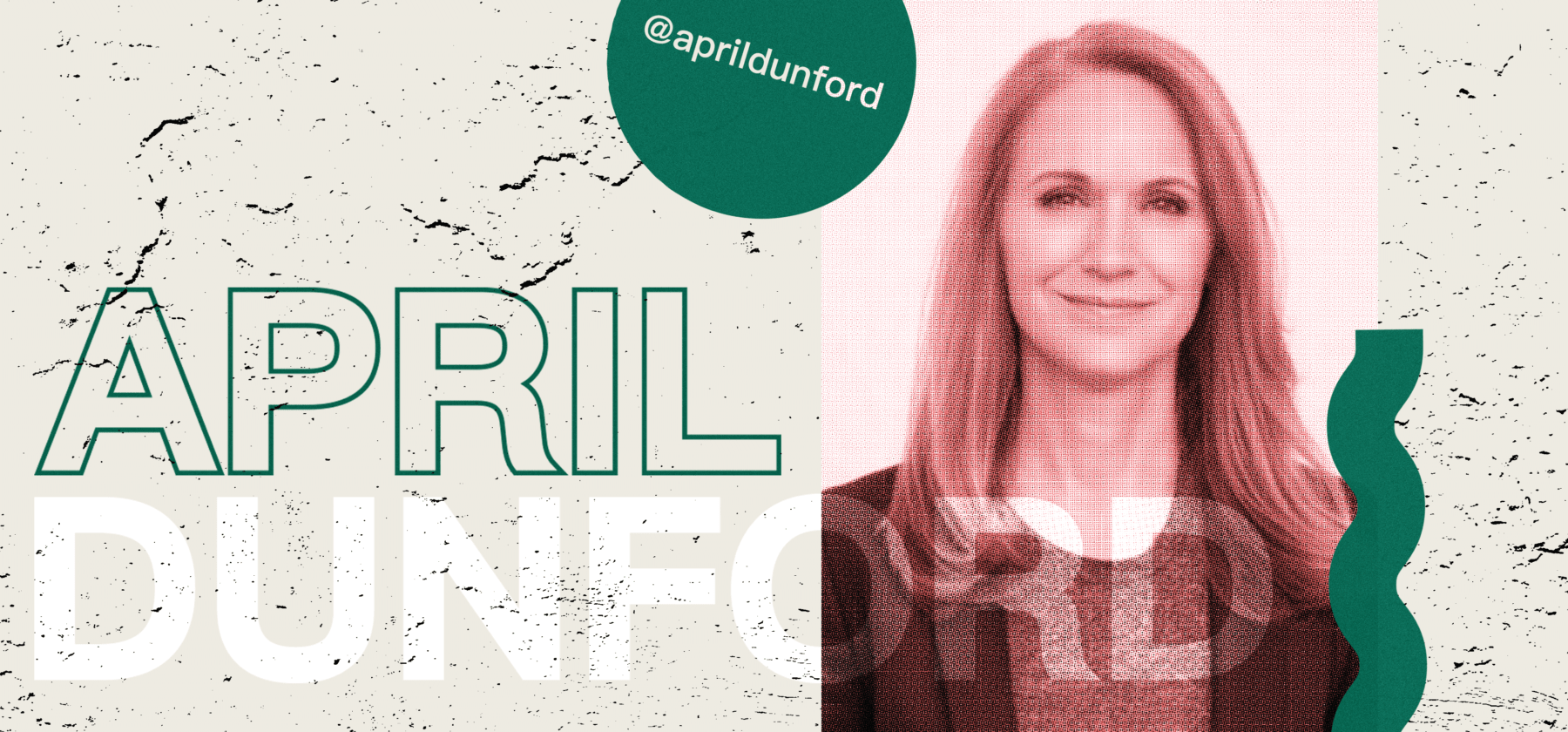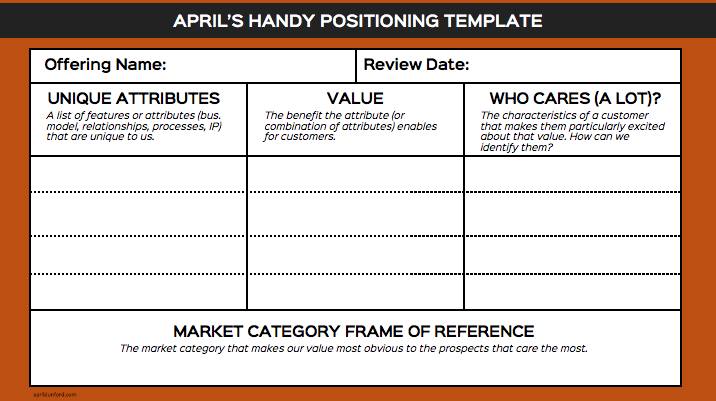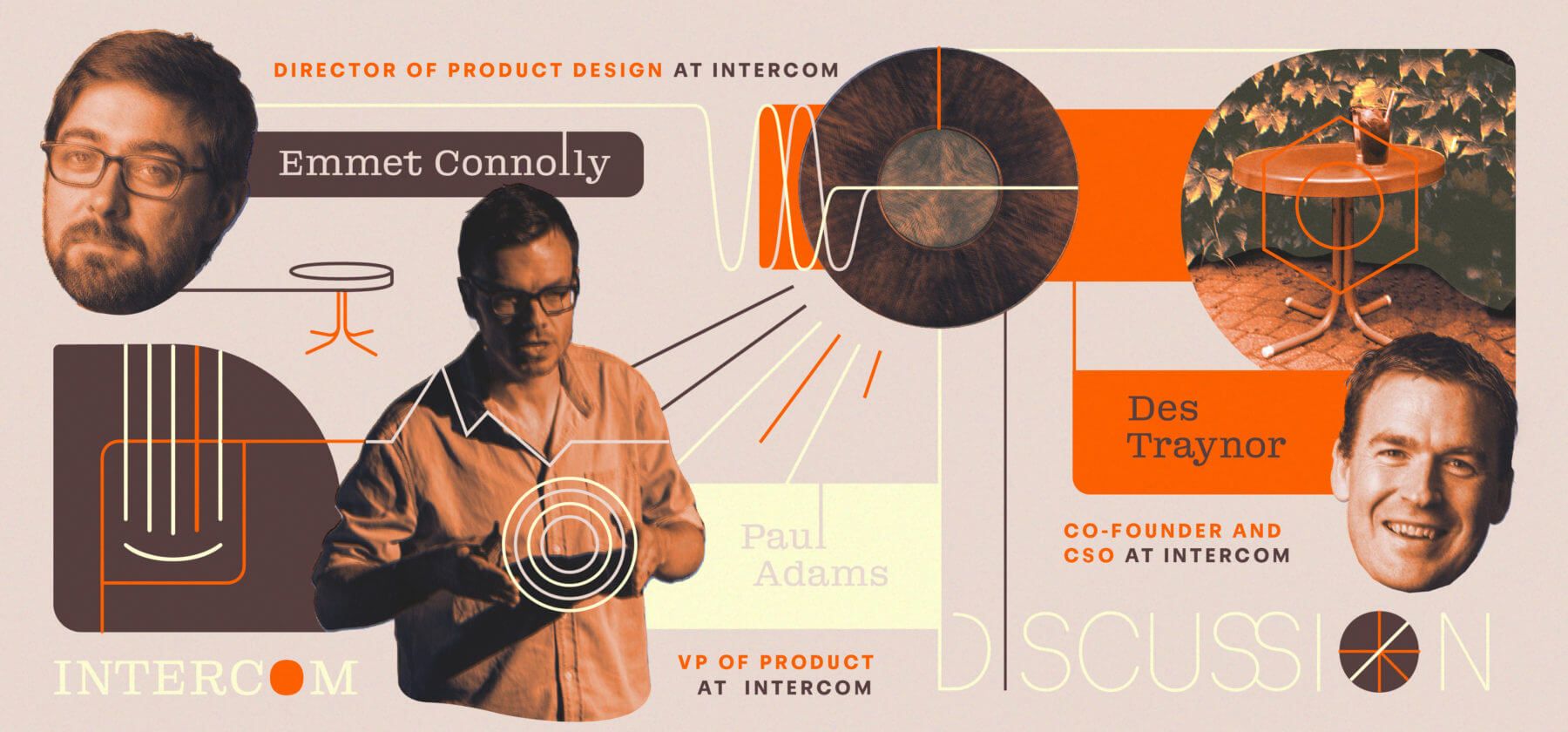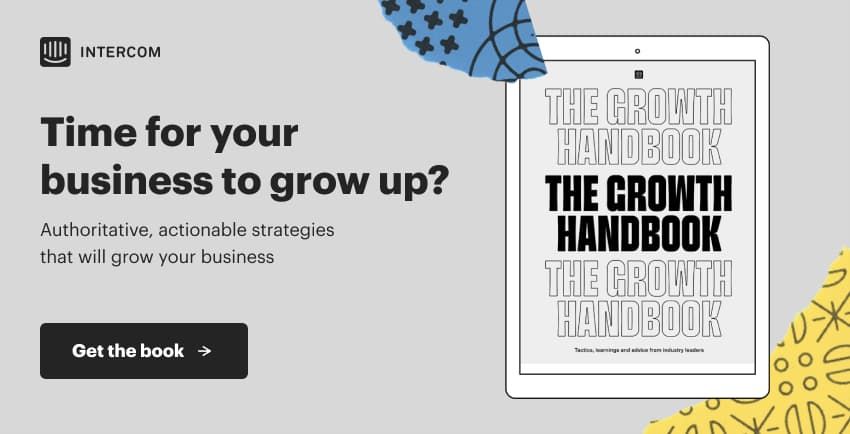
Understanding your ideal customers and how to sell to them
You've probably heard this before: "What gets you to your first $50 million is not what’s going to get you to $100 million."
We’ve thought about this truth a lot during the last few months at Intercom as we’ve been going through our annual planning. As part of the process, we’ve spent a lot of time reviewing who we should be selling to these days, and how we should be selling to these customers. The process of defining your positioning strategy is not a one-and-done deal – in a crowded marketplace, it needs to be an ongoing exercise. And as the organization grows, the work involved to get teams aligned on who you’re selling to and how you’re selling is not something to be taken for granted either.
For today’s episode, we’re sharing go-to-market insights from past interviews that have resonated with us. They include:
- Close.io co-founder Steli Efti on defining who you should and shouldn’t be selling to
- Ambient Strategy founder and CEO April Dunford on the symptoms of weak positioning
- Emergence Capital Growth partner Doug Landis on telling a story that sells
- Intercom’s own Des Traynor, Paul Adams and Emmet Connolly on aligning product and sales
- Salesloft CMO Sydney Sloan on aligning sales, marketing and support
To hear each of these conversations in full, check out episodes of our podcast linked in each section below. You can subscribe on iTunes, stream on Spotify or grab the RSS feed in your player of choice. What follows is a lightly edited transcript of the episode.
Steli Efti on understanding your customers

Adam Risman: What do you remember most about the earliest days of going and selling this product to customers? What worked well for you? What didn’t?
Steli: The number one thing that we learned was that we really needed to understand who our ideal customer was. It’s not only important to know what you want to do, or who you want to focus on, but you also need to be explicit about who you’re not going to serve.
Sometimes it’s hard to stand your ground. When you say, “We’re not going to do enterprise sales,” and then a massive company waves a massive number of potential dollars in your face, it’s easy to compromise when you haven’t written that out explicitly.
Before we even launched Close, we did a few things that were incredibly helpful. We defined our ideal customer, but we also said, “Here are the types of customers that, if they come our way, we’re gonna turn away.” We didn’t just have an ideal customer profile; we had a non-ideal customer profile as well. We did the same thing with our product: we had a product roadmap, and we had an anti-product roadmap of things we’re not going to build.
“You need to be explicit about who you’re not going to serve”
In the early days, as you get a little bit of publicity and people start spreading the word, you get all kinds of requests and attention and potential customers coming your way. That makes it very hard to focus and prioritize. When you’re a small team, your time is everything. Speed is everything. If you go super broad with a tiny team, you’re going to waste a ton of time. This is something that we saw with a lot of our startup clients, and a mistake we didn’t make with Close, which I am very grateful for.
We truly understood whom we wanted to serve and whom we didn’t – and we knew how we wanted to deliver value and the things we wouldn’t do or build, even if they seemed popular. I think that helped us to be super laser focused.
Adam: What types of inputs did you have in terms of creating your ideal customer profile? What kinds of questions did you ask?
Steli: We asked ourselves, “Who is the type of customer we truly understand better than anybody else in the marketplace, and who is the customer we truly care about?” For us, it was clear that startups and small businesses were the types of businesses we understood. A lot of people in our company are entrepreneurial and have run businesses before, so it was an audience we intimately understood. The idea of making a massive conglomerate a little bit more efficient was just not exciting to us, even if it meant millions of dollars.
The other thing was that we believed sales at its core was about result-driven communication – and if this was true, by definition we needed to focus mainly on creating communication software for people doing inside sales. The people who would talk virtually with their customers instead of field salespeople, which is a sector of sales that is in decline. Being an amazing tablet field sales CRM platform, and being an amazing inside sales, call, email, communication based platform, they aren’t the same. To be great at one thing, you have to compromise on the other.
When you say you don’t want to focus on single users or massive Fortune 500 companies with thousands of employees, you’re left with the small and medium-sized companies that do inside sales. And on top of it, we decided to focus on the U.S., which meant having all our content and communication in English and centered on the U.S. dollar. From day one, we did have customers all around the world, but we didn’t focus on them. We didn’t do any extra work to make it better or easier for these types of international customers to purchase us.
We had to keep things very simple and focused for a small team like ours to be able to do a good job and grow.
April Dunford on the symptoms of weak positioning

Geoffrey Keating: Let’s take a hypothetical example: say you’re launching a brand new product tomorrow. What are the first steps you’re taking to understand how to position it?
April: Most companies start with an idea to make an existing thing better. They’ll say, “We’re going to build a better email system.” Or, “We’re going to build a better CRM or a faster database.” They iterate on the product, and they get it into the customer’s hands. The customer says: “I love these features. I hate these features.” After they go through this period of monkeying around with the product, they have something customers love, and they start selling it.
Often, they never revisit that positioning. They just say: “We started out to build a database. This is obviously a database.” Or they’ll say, “It’s obviously a CRM.” But quite often – if you were the customer having no prior experience with it – you might look at and think, “No, that’s not CRM, that’s chat.” Or, “That’s not email, that’s team collaboration.” What startups need to do is to be able to back up and say, “If I put my customer hat on, what is the best context I could weave around this product so that it makes sense to people when they first encounter it cold?”

Geoffrey: As a consultant, are there particular mistakes or challenges people are coming to you with when it comes to positioning?
April: Most of the time, weak positioning manifests itself in a bunch of ways. The most common symptom of weak positioning is people just don’t understand what you do, or you get compared to competitors that the company says aren’t your competitors at all. And yet customers keep thinking you’re just like them. You’ll see this weakness in the funnel in different ways.
Often, it’ll be difficult to get a lead into the funnel because people don’t understand what it is. And then sometimes, what you’ll get is a lot of friction in the middle of the funnel, where you can see customers wrestling with the question: “Is this really what I need? Is this really what’s going to solve my problem?” Then you’ll get a lot of churn on the backend where they think you do one thing, but when they actually get their hands on it they’re like, “Whoops, this is something else.” And they’ll churn out on you. You tend to see those symptoms quite a bit.
Geoffrey: When features, products can be replicated so easily, positioning becomes so much more important. For our listeners, is there any sort of advice you’d give them to stand out in this particularly crowded marketplace?
April: I think the best thing B2B SaaS vendors can do is stay really focused on their differentiators because there are things about your solution that your best customers really love about you, and the rest of it really doesn’t matter. I know we want to talk about all the things, but the best thing to do is just to hone in on your secret sauce: “This is the thing we do better than anybody else. If you don’t care about this stuff, we’re not the solution for you.” Most B2B SaaS vendors get into trouble when they start to tell me about every single little thing about what they do, and some of it’s their secret sauce and some of it’s just meh – it’s just like everybody else’s thing, but they’re trying to sell too much stuff. What happens is you end up looking like everyone else.
So, I think it’s important for SaaS companies to get their best stuff out front. Then you’ve got lots of time later to do the checkbox for the nine million other features you’ve got. You can worry about that later. If people understand your core value and your core differentiators, then you’ll stand out on your own from all these other folks who are like, “Hey, we’re everything for everybody.”
Doug Landis on telling a story that sells

Doug: So many people write their customer stories as “Here’s the problem, here’s how we solved it, and here’s our ROI.” That doesn’t mean shit. All a salesperson is going to do is state a bunch of facts and bullets. I want to know the glue. I want to know who that person is. I want to know what they’re really struggling with. I want to know how their world could be different if they just opened their eyes or thought about it differently.
I did a couple of things: I met with everybody in customer success and tried to extrapolate the best stories possible. Then I tried to reorient them and give them back to marketing. I’d say, “If you’re the Head of Security and you’re building your security deck for our reps to use, we need to reorient it and make sure we’re using the voice of our customers in these tiny stories.” Our job is to help our customers identify problems they haven’t quite considered, and we’re going to pull those problems out of our existing customers. Then we’ll share them internally both with marketing and sales so that it reorients our conversation.
“Our goal is to get customers to look at us and see something they hadn’t considered before”
Lastly, and probably most importantly, we rewrote our whole first call deck. If you look your very first one, probably the first slide is “here’s who we are,” and then the second slide is “here are all our customers,” and then the third slide is “here’s the problem that we’re trying to solve.” That’s a problem, because the first three or four slides are all about you.
Customers want to know about themselves, and the only way they can compare themselves is if you give them insight into other people just like them. The first slide should say, “Listen, this is what we learned from our customers, who we feel are pretty similar to you. And the truth is, while you may think this is your fundamental problem the reality is that you might have problem 2, 3, 4 and 5. And if you don’t have those problems now, it’s quite possible you’re going to experience those down the road. If you think that’s possible, then let’s dig into what those problems could fundamentally mean to you and how to think about solving those.”
Adam Risman: You mentioned finding ways to share these internally, particularly in marketing. I’m curious how that went and how you were able to develop some consistency there, because marketing typically is we’re speaking to the masses.
Doug: First, you have to create a template for marketing that reorients the way in which they build decks. This is no offense to anybody in marketing, but in product marketing your job is to translate from the product managers what the product is all about, the value that product delivers and the ROI that you can hopefully deliver by using this product. What’s missing in all of that is the customers. At the end of the day, your product is solving a particular problem, but you have to show how you validated that. Is your product solving more than one problem? Most likely it is, so how do you want to talk about it?
Our goal is to get our customers to look at us and see something they hadn’t considered before. Chris Voss, one of FBI’s best negotiators for 25 years, wrote a book called Never Split The Difference. One of the things he gets you to think about in the world of negotiation is not getting somebody to say “yes,” but to get them to say, “That’s right.” The moment they say that, you now have proof that you built enough empathy and demonstrated your level of understanding to them. The moment that happens, you’ve got them.
Adam: What do you see as the cornerstones of a really strong compelling story? And I don’t just mean beginning, middle and end, but what elements have to be there to get the person who’s receiving this to the end?
Doug: Contrast. Contrast is one of the most powerful vehicles for storytelling. It’s where are you today versus where could you be tomorrow. It’s what do you have now versus what could you have. Old way, new way – it’s all bout contrast. And it’s not contrast by me simply telling you about it, but it’s me using examples. Me telling you is not necessarily all that believable. If I got it right, then maybe it’s a little bit more believable, but in many cases we’re kind of guessing, because we don’t know exactly what’s going on with our customers. Contrast is a really, really important vehicle.
Analogies are another really important vehicle. We speak our own speak, drink our own champagne and eat our own dog food. Whatever it is, our customers don’t get it. So using analogies and metaphors is really an interesting way to actually help make complex things actually sound simple.
This goes deeper than saying you’re “the Airbnb of X” or “the Uber for Y.” That’s super surface level. Let’s use Box as an example: Box for many people is about syncing and sharing file storage. Okay, that’s true, but it’s so much more. So how do you get people to understand how much more it is, when they’re thinking, “No, it’s just storage and storage is cheap, so why the hell am I going to pay $35?” You have to reorient their thinking. An analogy is a really good way.
“Contrast is one of the most powerful vehicles for storytelling”
When it comes to thinking about analogies, sit in a room with your sales team and your marketing team, and write on a whiteboard your company’s name. Let’s use Intercom as an example: Intercom is like, dot, dot, dot, and leave it and let everybody just brain dump. Intercom is like your personal concierge or Intercom is like your favorite barista at a coffee shop. You walk in, they have exactly what you want, you don’t even have to blink to get your coffee. That’s a great exercise to come up with analogies for your company. Have everybody brainstorm and get creative. Just nothing is wrong or bad, and then you’re going to find a couple that really stick and that’s what’s going to help you use analogies to help explain who you are and what you do.
Of course, you got to have emotion, which is why we’re using more adverbs. We’re using descriptive language to talk about what’s really going on versus facts and statements. Facts, by the way, are the other thing that’s really important. When you state a fact, the first thing we do by default as human beings is argue against that fact. We don’t believe it. You tell me a fact, I’m like, “Where’s your proof?” Especially if you’re in sales. If you’re in sales I’m already defensive, and then you throw out a fact and I’m wondering, “How do I know that’s true?” Be really mindful about using more emotion versus facts. Facts you can use to back up the story that you just told. It’s a great little one-two punch.
Des Traynor, Paul Adams and Emmet Connolly on listening to your unmet customers

Des: Paul, one area where I think I experienced a change in how our product engineering teams work is in our relationship with go-to-market teams – specifically how we deal with some of our larger customers or prospects. One thing that occurred to me very early on when I moved back to R&D (or to Product and Engineering land) was how we have a lot of inputs to our roadmap. But one customer whom it’s fundamentally impossible to listen to is the voice of the customer who couldn’t adopt to your product. I’m talking about someone who ultimately couldn’t agree to buy it because of a shortcoming. Everything else has its way onto the roadmap with the exception of this, right? After multiple conversations with the folks in sales, you took point on this. Talk us through it what we changed there.
“But one customer whom it’s fundamentally impossible to listen to is the voice of the customer who couldn’t adopt to your product”
Paul: Yeah, it’s interesting to try and track the journey over the years, because Intercom’s changed a lot. There are lots of people listening to this, and you have companies of all different types and sizes. And when we were smaller, our self-serve channel was so dominant, at least in how we thought. You know, people just went to our website. They found about us by word of mouth, Twitter, talking to people they know in the industry. They went to our website and signed up themselves, and they were up and running. As we got bigger and bigger, and as people got to know Intercom, we got bigger companies knocking on door with more complex requirements. Often, I used to talk to someone because, as good as any marketing might be, they’re just not going to answer every single question people have. I found that we started to have more and more companies who just wanted to talk to us about Intercom. So our sales team kind of grew out of that, and it’s been really successful.
And as you said, there was definitely a lag between the sales team growing inside Intercom, and us in product engineering actually realizing that we needed to listen. You know, we’re very open. It wasn’t like it was a deliberate thing. It was just more that we were a little lagging. The hard lesson I learned was: “Oh, shit. There’s a whole critical input here that we’re just missing.” And so we changed that. But you know what we didn’t do, very explicitly, was whatever the respective customers were asking us for. That’s obviously not a good path; it’s a path to ruin over some period of time. If you just start building one-off features and changes, that just make your product a big mess. So like we’ve always done with operations and process, we sat down with the sales team over the course of weeks and months and together, very collaboratively, built a process. We iterated it over the year, gathered all the inputs we were hearing, synthesized them and pulled out the patterns.
“We directed the sales team to have the customers think in terms of the problems that they had”
One big change was that customers typically ask for very specific features. But we directed the sales team to have the customers think in terms of the problems that they had. It was kind of like a classic design thing; if you’re in the world of design, it’s a very common way to think so that you ensure you understand peoples’ problems and figure out the best solution. But you know, if you live in the sales world, that’s not common. So, it was awesome. We built this process together called “Problems To Be Solved,” which is very self-explanatory.
Des: Borrowing from Jobs To Be Done.
Paul: Exactly, yeah. It’s got an acronym too: PTBS. It’s literally a list of prioritized problems to be solved. And it’s taken from hundreds and hundreds of weekly and monthly sales conversations to create a new input around making Intercom better based on the things that prospective customers are looking for.
Des: And obviously they have to be traded off against the current customers, the things we have, the ideas we want to build and all the new shit we have to do in a given year. It’s been quite a force of maturing for us, I’d say, to bring in the sort of voice of the unmet customer.
Paul: Very much so, yeah.
Emmet: It’s just one of those things that’s a no-brainer in retrospect, as well. It’s something of a truism among designer/product people to “know your user.” Nobody talks about knowing your prospective user: the person who isn’t a user because you have already failed them.
“Nobody talks about knowing your prospective user: the person who isn’t a user because you have already failed them”
Des: I think that’s exactly it, especially where it’s a blocker. These aren’t people saying, “I’d use you if only you’d also add five more features so I could do face ID tracking.” It’s always, “I want to use you exactly the way you intend to be used, but I just need this extra piece of permissions or security or settings to actually unblock me and my team from adopting.” They want you to unlock an extra piece so they can adopt a tool that meets their standards and criteria.
Sydney Sloan on aligning sales, support and marketing

Alexandra: What about your partnership experience with sales? Can you talk a little bit about how you work with the support and sales teams at SalesLoft?
Sydney: SalesLoft has been different than any company I’ve ever worked at before, and that’s one of the things that drew me there. The company is committed to putting customers first. One of our other cultural values is “team over self,” and we truly have an account-based strategy for the company. The questions we ask are: who are our target accounts, how are we engaging them, what can marketing do and what can sales do?
It is a true partnership, where myself and our chief revenue officer, Sean Murray, talk about the factors that categorize or quantify who our target accounts are. Marketing owns target accounts and the selection of the list. Then, we work with sales to prioritize those lists and define the segments we want go after and the methodologies for going after them. Then, we tier the accounts, and we invest more resources in the top tiers than the at-scale activities for the lower tier. That partnership is in place.
We also have a great partnership with the sales enablement team as they look to gather feedback, build messages and train. We use the insights from our product as to what messages are resonating with the customers. That’s been quite different than my previous experiences, where it was more on the traditional side, where sales is asking marketing, “Where are my leads?” Then marketing would say to sales, “Why don’t you follow up on my leads?” We’ve definitely heard that story before. It’s a true partnership.
I’ve only been at SalesLoft for four months, and a lot of the leaders are relatively new. What I love on the support side is that we identify best practices and benchmarks. There are two facets to that. One is that we have a roadmap, and we have a structure we can recommend customers follow, and we can help them evaluate where they are according to best practices. Customers can see, “Okay, I’m strong here. I’m weak here.” And we can work together with them on getting to the levels that they need to succeed. Those kinds of benchmarks and frameworks are a great partnership between marketing and the customer success team to leverage and help with customer acquisition. Data and benchmarks really help the customer see where they fit.
The other part to the customer success organization at SalesLoft is that they’re also our education team. It goes back to that idea that smart, happy customers buy more. We want to be the company that sales leaders come to for insights and advice on how to modernize their sales organization. The more we can partner with the education team on bringing those lessons to not only our customers but also non-customers, the more we will grow our awareness and our reach of SalesLoft.
Alexandra: How do you measure performance? You said that marketing is looking at the entire customer lifecycle, but what are the things you track as a CMO?
Sydney: On the high level of the dashboard, there are a couple of things. We track pipeline and impact on closed-won deals. That’s so important for marketing to do, to show the impact on the business. We want to see how much pipeline we are jointly developing on our target accounts and how much influence on those target accounts marketing is driving. Then we also look at inbound as a separate function. We are still tracking – even though it’s not in our target account – how much we are naturally drawing in. That’s a separate segment, but we’re not investing in that. That’s just coming to us. And we’re seeing how those trend over time as well as looking at the closed ratios and the conversions between the different stages at a cohort level. We look into our funnel and the performance of the funnel to continue to make improvements.
The other thing that I always look at is the opposite side of the coin. Am I investing the company’s dollars wisely in marketing? We look at our return on investment, and what I’ve learned over time is not to make it overly scientific. So, generalized feedback is sufficient in that we want to understand how much it takes to book a meeting. How much investment do we need on large enterprise accounts versus our commercial accounts that deliver different returns on our investment?
“It’s more important to look at the pipeline and how you’re contributing to it – and then figuring out together how to make sure you’re converting as much pipeline as possible”
I look at the differences between channels: which channels are performing? I know they’re going to be different, and that’s okay. It’s about setting expectations of what the return should be through those different channels, because we know that you have to have a mix. A field event might cost more, but I know what the return on that is going to be. We look at our overall return on spend and consider, for every dollar, how much are we returning to the business? The head of sales and I also keep our eyes on customer acquisition cost (CAC) for sales and marketing combined.
Alexandra: It’s very smart to look at blended CAC, because it’s really a combination of sales and marketing efforts getting you there. We share many of the same metrics. One of the things we try to do is build the alignment at the most senior level on the overarching metric. Sales and marketing share the revenue number, and that means we may control different types of inputs that go into the number one. We may be driving some of the leads and conversion rates, but it’s really sales helping with conversion rates, especially for larger customers. It’s a combination of both teams driving the output metric, but we share the same output metric.
Sydney: One thing I could just never get comfortable with is when the marketing team would be excited about all the marketing qualified leads (MQL) they were getting, while the sales teams are struggling to make the number. It just always felt wrong to me. MQLs can be manipulated, and so we can open them up and close them down. I really do think it’s more important to look at the pipeline and how you’re contributing to it – and then figuring out together how to make sure you’re converting as much pipeline as possible.
It’s important to do mid-stage metrics and mid-funnel marketing activities to continue to improve across all the stages. That’s the other key lesson. If there are other marketers out there who are still working with sales teams that say, “Marketing, don’t touch my deal now that I’m working on it…” That’s wrong. There’s so much marketing do to continue to keep the accounts warm and to bring new contacts into the equation. Hopefully sales teams are realizing that marketing can add value across all stages and beyond.








